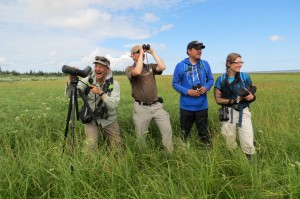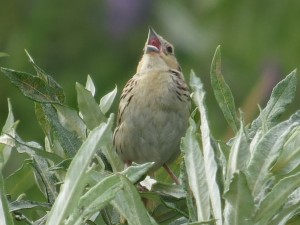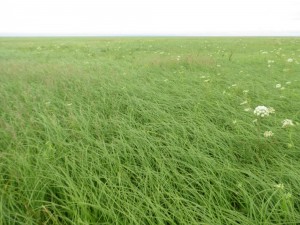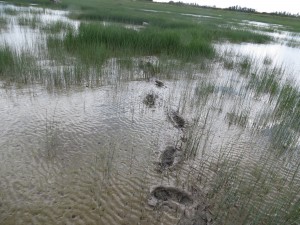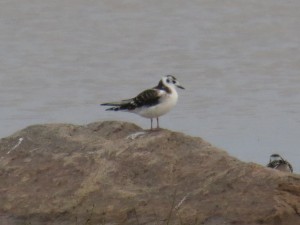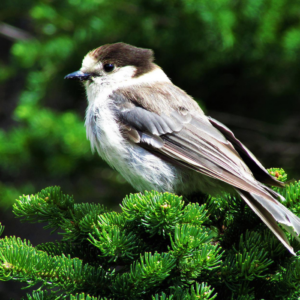Five days in the field on Rupert Bay, one to go
Report from the field by Ted Cheskey Planning travel on Rupert Bay is a gamble. Its broad reach, oriented to the northwest, from where blow the prevailing winds, mean its shallow waters can easily be whipped into a frenzy. The team of myself, Aurelie Bourbeau-Lemieux, a biologist working for the Cree Nation Government, Gary Salt, a local resident familiar with the capricious Rupert, participant in our March workshop on bird identification, and representing the Cree Nation of Waskaganish and the local Trappers Association, and Marc Antoine Montpetit, an expert birder and atlasser, volunteering on behalf of the Breeding Bird Atlas project of Quebec, were ready to go on Monday morning, but weather and various delays meant we were stuck in the community until Wednesday. One plus about the delays was that we were able to present our project and talk about birds to a group of 15 local youth taking a course on the environment, and recruit three from the group to join us in a few hours for our final trip (just for the day) to a few places we could not get to yet. Our work is being funded by Environment Canada’s Aboriginal Fund for Species At Risk, and our focal species are the Red Knot, Hudsonian Godwit (not yet on the list), Yellow Rail, Common Nighthawk, Short-eared Owl, and Olive-sided Flycatcher. Marc Antoine is focussing his efforts on breeding birds, gathering evidence of breeding of all of the species we observe, and targetting a few specialties for the area, including Little Gull and LeConte’s Sparrow . Over five days we visited five different locations, being transported to each by boat from two different camps. Families have hunting camps around the bay, and we have been able to arrange accomodation with the camp owners, as they are used infrequently this time of year. It rained every day, some days more than others, and the biting insects would be severe for the faint of heart. Some of our days involved trudging over 10 kilometres through boot sucking mud, waist high soaked vegetation with no terra firma, and tricky passages concealled benath the vegetation, that were riddled with a minefield of bottomless pools of muck that could be trip-enders. It wasn’t all like that. Some areas where realatively dry (truly a relative concept here), and there even are stretches of sandy beach in places between the mud flats and the limits of the boreal forest. But, working on these surveys is very physically demanding, and one must not be easily discouraged by challenging conditions. I certainly admire the great work that has been done on the Ontario side of James Bay by CWS, MNR, ROM, Moose Cree, BSC, OFO, more many years. The birds have been pretty impressive. We have been able to sample most of the habitats that we had targetting, though not all. Some highlights from the first day were seeing several Little Gulls, a species that is rare in North America, but which seems to be breeding locally here. Though we did not find a colony, we did observe a few adults and juveniles. Another breeding bird target was the elusive Yellow Rail, one of the most secretive birds around. Previous studies by Michel Robert, coordinator of the Atlas of Breeding Birds of Quebec, suggested that this bird is abundant in one particular part of the Bay called “Cabbage Willows”. The rail makes a sound like clicking stones together in a 2-3 rhythm mostly. We were very successful, finding 18 territorial males on transects through their soggy sedge and forb habitat. We were also successful in finding the two sparrow specialties of the coastal marshes: Nelson’s Sparrow and LeConte’s sparrow, counting about 200 territorial males of the former and at least 30 of the latter. We have observed several Common Nighthawks in different locations both in Waskaganish and along the coast. Finally the shorelines of Jacob Island, a small Island at the mouth of Rupert Bay, appears rich in migrating shorebirds, as we identified 15 species in a few hours of surveying three kilometres of shoreline, including over 200 White-rumped Sandpipers, over 100 Hudsonian Godwits, a Marbled Godwit, and 14 of the endangered Red Knots. We are grateful for the Cree Nation of Waskaganish and Environment Canada for supporting this project, which we hope to continue into the future as we build connections in the community and continue to gather evidence in support of eventual Important Bird Area designation.
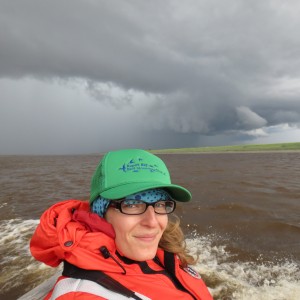 Aurelie with storm in background by Ted Cheskey
Aurelie with storm in background by Ted Cheskey

